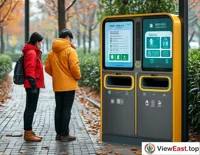







In China, the construction of smart cities is like a quiet revolution that has not only changed the way cities are governed but also improved the quality of life for urban residents. At the heart of this revolution is the use of advanced information technology to achieve intelligent city management, convenient services, and scientific decision-making, thus promoting the modernization transformation of urban governance in China.
The Dawn of Awakening: The Sprouting of Smart Cities
The story begins with the rapid development of urbanization in China. As urban populations surge and city sizes expand, traditional urban management methods face unprecedented challenges. Against this backdrop, China began to explore the construction of smart cities, aiming to enhance urban management efficiency and resident quality of life through technological means. In the early 21st century, China launched pilot projects for smart cities, marking the sprouting of smart city construction.
The Blueprint of Planning: The Layout of Smart Cities
With the proposal of the smart city concept, China began to draw up blueprints for smart cities. Urban planners integrated information technology into all aspects of urban development, from traffic management to public safety, from environmental protection to medical services. The construction of smart cities covers every field of urban management. The implementation of these plans has brought more efficient services and more convenient lives to cities.
Technological Innovation: The Driving Force of Smart Cities
Technological innovation is the core driving force behind the construction of smart cities. The application of the Internet of Things, cloud computing, and big data analysis has made urban management more intelligent. Intelligent transportation systems reduce traffic congestion, smart grids improve energy efficiency, and smart security systems enhance city safety. These technologies provide strong support for the construction of smart cities.
Convenient Services: The People-Oriented Achievements of Smart Cities
The most direct result of smart city construction is the convenience of services. Residents can easily pay utility bills, inquire about public transit routes, and make medical appointments through smartphone apps. Government departments, using big data analysis, can more accurately meet citizen needs and provide personalized services. The construction of smart cities has brought urban services closer to people's lives, increasing resident satisfaction.
Scientific Decision-Making: The Governance Efficiency of Smart Cities
Smart city construction is also reflected in the scientific nature of decision-making. Government departments use big data and artificial intelligence technologies to analyze urban operation data, thus making more scientifically sound decisions. This data-based decision-making approach improves the precision and effectiveness of urban management and enhances the city's ability to respond to emergencies.
Future Outlook: The Bright Prospects of Smart Cities
Looking to the future, the construction of smart cities in China will continue to deepen. With the application of new technologies such as 5G and artificial intelligence, smart cities will become more intelligent and human-centered. The construction of smart cities will bring a better future to Chinese cities and provide Chinese wisdom and solutions for global urban governance.